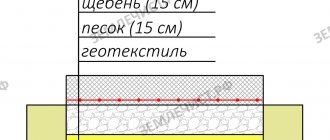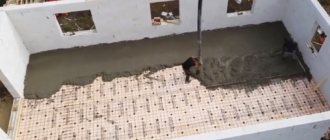- 1 Disadvantages and advantages
- 2 Application
- 3 Installation
- 4 Execution of work
- 5 Selection and marking of territory
- 6 Drilling
- 7 Installation of reinforced concrete pillars
- 8 Control over the work
- 9 Laying electrical wires
- 10 Conclusion
Today humanity cannot imagine existence without electricity. The uninterrupted supply of electricity to each room depends on the proper installation of networks from the substation directly to each consumer. This goal led specialists to the invention of reinforced concrete electric poles. The devices do their job perfectly. Before starting work, you should calculate how much the materials cost and how long the installation will take.
Disadvantages and advantages
Before making an electric pole, it is necessary to take into account the advantages of such supports. The advantages include durability. Reinforced concrete electric poles can serve consumers for many years. It is important to take into account that high-quality building materials should be used when constructing supports. They are more expensive, but their use guarantees the durability of each concrete pillar.
Another advantage is the ability to choose a design. Using additional building materials (panels and other means), you can create concrete supports. In addition, during installation work, specialists will not need expensive special equipment. This allows you to do the installation yourself and not have to turn to professionals.
How many disadvantages do such supports have? A concrete electricity pole has only one drawback. We are talking about laying the foundation, which is necessary in order to reliably install a reinforced concrete electric pole. Otherwise, the structure may fall.
Return to contents
Why do you need a pillar?
An electric pole is a product made of concrete and reinforcement, from 9.5 to 13.5 meters . The latter is sufficient to organize reliable anchorage in the soil. Its installation is regulated by a number of regulatory documents. This stage in the electrification of the private sector plays an important role, especially if the connection point is located at a distance of 45 meters or more from the common line - the maximum distance between poles.
On a private site, organizing a high-altitude connection point is a prerequisite. As a last resort, one pole can be used to electrify several areas, subject to acceptable design placement.
In addition to wires, it is allowed to install external lighting with a connection to the meter, as well as video surveillance devices, but not lower than 1.2 meters from the passing 220 V wire.
Installation
When installing an electrical concrete pole, it is important to comply with a number of conditions. First of all, builders must take into account the landscape, the strength of wind gusts in the region, and the density of vehicle traffic. Specialists should also measure the distance between reinforced concrete supports. You need to determine how many meters there are between each pillar. During installation work, the strength of the supports is carefully checked.
Return to contents
Advantages of reinforced concrete electric poles and their production
Electricity poles with a concrete base have a number of advantages:
- high resistance to temperature changes (from -55 to + 55°C) and environmental influences (hurricanes, precipitation);
- high resistance to aggressive environments and external influences;
- fire safety;
- possibility of endless production;
- low cost and, as a result, the price of products;
- possibility of long-term operation of the product (more than 50 years);
- ease of installation and maintenance.
Mold for making concrete pillars.
The technology for manufacturing reinforced concrete pillars is simple and does not require qualified personnel and high-precision modern equipment.
A frame mesh is welded from iron reinforcement of a certain diameter in accordance with TU or GOST. This iron frame “frame” is placed into a mold and filled with concrete mortar of a certain consistency (grade cement/sand/water/any additives). The concrete hardens and after some time the form is disassembled, and the finished product “in the air” finally acquires its performance characteristics: strength, resistance to various aggressive environments, ignoring corrosive processes.
Execution of work
For uninterrupted transmission of electricity, it is necessary to install the structure in accordance with safety regulations. To ensure proper construction of supports, builders should adhere to the following rules:
- install poles depending on the purpose, terrain features and laying, special equipment systems;
- carry out high-quality installation work;
- secure the wires to the poles according to all the rules (PUE).
Each reinforced concrete support is installed in stages:
- First you need to mark the selected area.
- Then specialists begin drilling holes for the pillars.
- After this, you can begin installing the supporting structures. Special equipment is used for this.
- The last stage is the installation of electrical wires.
Return to contents
The advantage of reinforced concrete supports (power lines)
Reinforced concrete lighting poles with different installation methods.
In the USSR, all power lines that connected power plants with populated areas were made of metal, and at that time there was nothing better or stronger. But with the development of modern science, high-strength cement grades began to appear in the specialized industry, which make it possible to produce high-quality and cheaper supports for power lines.
Advantages of reinforced concrete supports for power lines:
- concrete supports are less susceptible to corrosion processes;
- low, compared to metal ones, the cost of the product;
- lower operating costs;
- longer operating period;
- installation of one structure requires less material costs;
- with significant temperature changes, concrete is less exposed to the atmosphere than metal.
Nowadays, all installation work is extremely mechanized. The holes for installing reinforced concrete pillars are made by specialized machines. Products are installed in the pit by powerful multifunctional truck cranes. Concrete is delivered to the site by automixers and does not need to be heated by fire, as in the old Soviet film. Concreting is done automatically, not with shovels and buckets.
Selection and marking of territory
Drilling a hole for electrical poles.
For proper installation of concrete structures, it is necessary to adhere to safety rules. In particular, marking the selected territory involves choosing the location for erecting supports and determining the distance directly between the pillars.
The calculations should take into account the expected loads, as well as the characteristics of the specific area and soil. The marking should be done in such a way as to achieve uniform illumination of the areas by each pillar. Specialists carry out installation according to installation technology. When marking, determine the number of concrete pillars and their location.
Return to contents
Requirements for power lines up to 0.4 kV in populated areas
Voltage 0.4 kV is the maximum for input into a private house. For such lines within cities and SNT, requirements have been developed for the distance from supports to utility facilities.
Diagram indicating the distances from supports to residential buildings
The distance between the line posts is no more than 50 meters. It depends on the wind and snow load in the installation region. All calculations are made by specialists. The distances they recommend should not be exceeded.
The maximum distance from the main support to the wall of the house is 25 meters. Otherwise, you will need to install additional supports.
The distance from the main to the additional distribution pole is not clearly standardized. Its location must be determined by analyzing the site plan, points of entry of electrical lines into the house and installation locations of the main supports.
The sag of the tensioned wire in the roadway area should be no more than 6 meters above the ground, and in the pedestrian path area - 3.5 m.
The distance from the additional distribution support to the wall of the house should be no more than 10 m and no less than 2 m. From the fence to the support should be at least 1 m, which is enough to provide space for electricians if it is necessary to carry out work on the pole.
The support is not prohibited from being located on the inside of the site. However, it is necessary to ensure unimpeded access to it for energy services.
The minimum standard height for cable entry from the power line into the house is 2.75 m.
Installation of reinforced concrete pillars
Installation using a manipulator.
Before starting work, it is necessary to double-check the supporting structures for possible cracks. Their vertical alignment is carried out using special levels and other means. A manipulator is used to erect concrete pillars. Thick cement mortar is poured into each hole where the supporting structures were installed. To give structures additional stability, specialists install supports made of reinforced concrete or metal.
Return to contents
Requirements for a summer cottage
The PUE does not divide buildings into urban and suburban and imposes the same requirements on all objects, since the location of the property does not in any way affect fire safety.
The only difference is the procedure for processing documents for electrification of a site.
Trained teams must install power line poles in SNT
The electric grid facilities of SNT, ONT or DNT are public property. There are no representative offices of energy companies on their territory. Therefore, a standard connection agreement is concluded between the partnerships and the network company.
In other words, the issue of electrification will have to be resolved not directly, but through the chairman of the partnership. All members of the partnership, as well as persons living with them, have the right to join the networks.
The agreement between SNT and the network company stipulates the maximum power allocated to gardening. This means that if, when connecting a new garden house to electrical networks, this limit is not exceeded, the partnership will not have to coordinate the connection and renew the contract.
A member of the partnership must write a statement addressed to the chairman. Acceptance of this document and the right to connect to electrical networks cannot be denied.
After connection, electricity is paid to the responsible person from SNT, who pays the network company according to the installed meter.
Control over the work
When installing and assembling supporting structures, you must carefully monitor strict adherence to the following parameters:
- Measuring a hole intended for reinforced concrete supports. For reliable installation of the structure, the pit must be deep.
- The quality of the material from which the structure is made. If the reinforcement is visible and cannot be covered with concrete mixture, the product will soon begin to collapse.
- Specialists must install metal spacers in the dug hole in the place where the post comes into contact with the ground. Zeta Workers should cement the support structure with high quality cement mortar.
- Specialists need to install the structures in a strictly vertical position using a special plumb line.
Return to contents
Electric poles: what they are made of, installation rules, operating time
It is impossible to imagine the modern life of people in large industrial centers, in megacities and in the most “seedy” village without concrete electric poles. Humanity has not yet come up with another way to supply electricity from transformer substations to those areas where people live, other than through wooden or concrete poles.
Types of concrete pillars.
Electric poles for supplying energy from transformers to consumers are made of two types: wooden and reinforced concrete. In the Soviet Union, during electrification, wooden poles were installed for electricity, because reinforced concrete ones had not yet been invented. Nowadays, there is a widespread replacement of outdated wooden electricity poles with reinforced concrete products, even in places where there are no problems with forests.
Wooden electricity poles are used in places where it is very expensive to deliver reinforced concrete ones or there is no possibility: taiga, regions of the Far North, etc.
Laying electrical wires
The final stage is laying electrical wires.
After installation is completed, the installation of metal structures to attach the insulators begins. In this case, clamps are used. There are also traverses that are not intended to transmit current. They are only needed to secure electrical wires. Their size will depend on the number of electrical wires they have to hold.
To prevent possible corrosion of the traverses, it is necessary to coat them with a special product that will ensure their protection. In addition, specialists secure a cover that will protect them from the harmful effects of the environment. The laying is completed with the installation of electrical wires. At the same time, workers must take into account that the above actions must be carried out by representatives of an organization that has the appropriate permit.
Return to contents
What does the price depend on?
First of all, from the materials used. Wood is highly not recommended for use. Cement, abrasive fillers and reinforcing materials – 70% of the retail cost. The remaining 30% are design features. The most expensive model - which can hold up to 9 high-voltage wires and 4 broadcast wires. The design parameter is also clearly stated in the permitting documentation from the regional power grid organization. For services, the latter may require from 700 to 2000 rubles .
Also, the final cost will be formed according to the following expense items:
- The power line support itself costs from 6,000 rubles .
- Delivery to the site by special transport and use of a hole drill - from 8,000 rubles . (depending on the remoteness of the final location of the site)
- Lifting and installation - from RUB 3,500 .
- Soil compaction - from 800 rubles .
- Electrician work on stretching and connecting cables - from 1,500 rubles .
- Purchase of cables – from RUB 3,000 . (changes based on the required footage).
In rare cases, project documentation may be free, with the exception of a fee of 300 rubles . To do this, several receipts are issued, with which you need to contact the cash desk of any bank.











